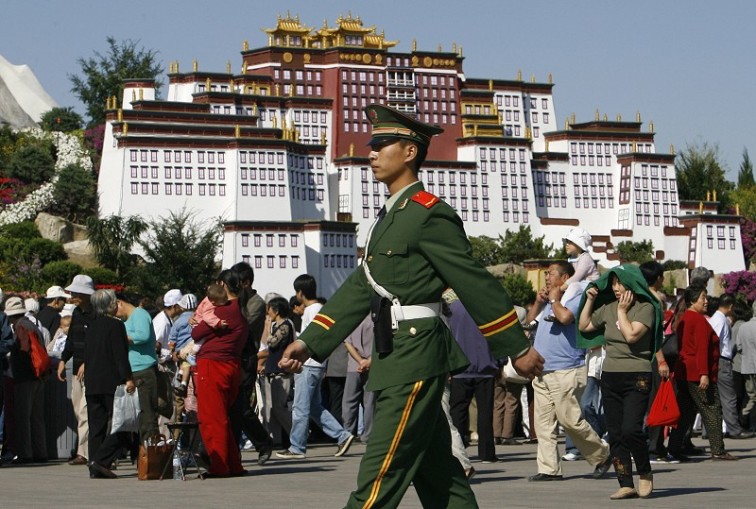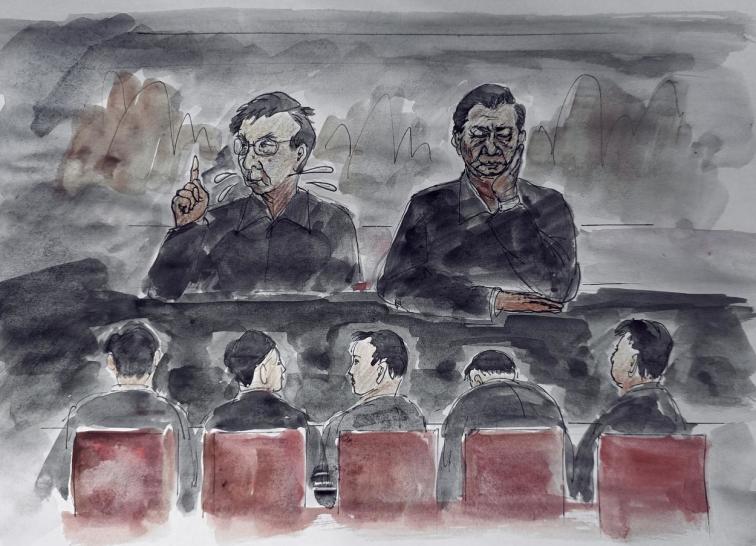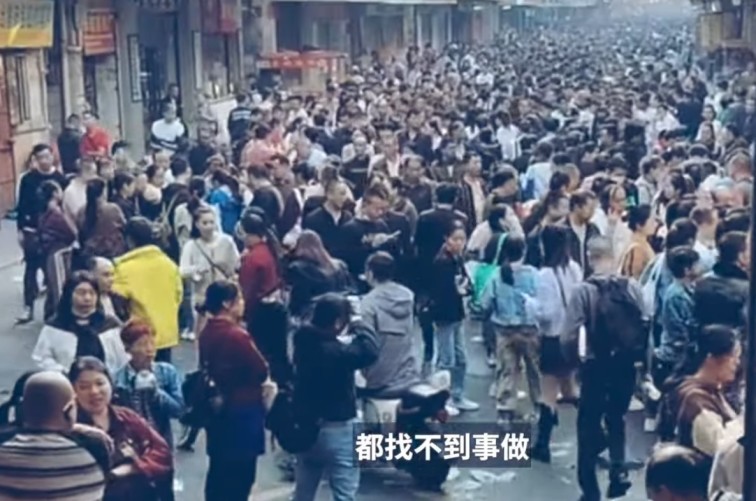On August 20, when Xi Jinping appeared in Tibet, observers noted his staggering steps and the distinct creases on his earlobes. (Online photo)
[People News] On August 20, when Xi Jinping appeared in Tibet, observers noted his staggering steps and the deep creases forming on his earlobes. Some insiders interpreted this as a possible sign of a stroke, predicting he may suffer another one in the near future.
Wu Zuolai published the “Four New Beidaihe Consensuses”, implying they were based on accounts from relevant insiders. The contents are as follows:
-
Stability comes first: Maintain the political status quo of the Party Central Committee and Xi Jinping, unify propaganda messaging, forbid personality cult–style promotion, and emphasise that “the Party commands the military, and the military safeguards reform, opening-up, and national stability.”
-
The General Secretary oversees the overall situation, but Party, state, and military functions are relatively decentralised—party affairs, state affairs, and military affairs are each handled by designated figures. Standing Committee members each have their responsibilities, exercising power through division of labour, cooperation, and mutual checks.
-
The Party Central’s coordinating body works with relevant departments to reform the Party’s internal election rules. Top Party and state leaders cannot serve more than two terms.
-
This coordinating body also manages preparations for the upcoming Fourth Plenum, whose main theme is to address the grave crises facing the Party and the state. After the plenum, preparations begin for the 21st Party Congress to ensure a smooth transition of power.
According to Wu’s interpretation, this coordinating body is composed of Party elders, who act as a counterbalance to Xi’s dictatorship—meaning Xi may retreat into the background.
However, Wu said he conducted an online poll about whether Xi would seek another term. 55% of respondents believed Xi would remain in power—an outcome Wu admitted left him disappointed.
If Chinese people do not take action now, then according to Professor Stephen Kotkin, the Harvard historian, Xi’s continued rule will usher in a “Stalin-style Great Purge.”
1. Xi Jinping Imitating Stalin’s Great Purge
The so-called “Great Purge” refers to a communist dictatorship using mass terror and indiscriminate killings, both inside and outside the Party, to preserve its rule.
Stalin’s Great Purge began after Lenin’s death in 1924, as he gradually consolidated his hold on the Party. From June 22, 1941, when the USSR entered World War II, until 1945, Stalin gained full control of the military, and the purges became even more frenzied. The killings only ceased after Stalin’s death in 1953, lasting 29 years in total.
According to a Dajiyuan article by Qiu Zhen (“The Soviet Great Purge”), Stalin’s first major purge was to eliminate Lenin’s old guard. This resembles Xi Jinping’s own purge after coming to power in 2012, targeting Jiang Zemin’s faction and the Communist Youth League (Tuanpai).
During the 17th Party Congress after Lenin’s death, of 1,966 delegates, 1,108 were arrested as “counter-revolutionaries.” Among 139 Central Committee members and alternates, 80% were executed. Of the 7 Politburo members, aside from Lenin’s death, 5 were executed. Of 31 Politburo members elected between 1919 and 1935, 20 were executed.
Government institutions were also ravaged: 2,000 People’s Commissariat staff were arrested. The Defence Ministry, Heavy Industry Ministry, Foreign Ministry, and State Planning Commission were gutted. This resembles Xi sidelining Li Keqiang and stripping the State Council of power.
The military was also savagely purged. Of the 5 Soviet marshals, 3 were eliminated. Of 80,000 officers, 35,000 were imprisoned or executed. Xi’s purge of the PLA shows clear parallels.
Stalin’s repression of intellectuals, educators, scholars, and cultural figures even preceded his assault on the political and military elites. Journalist Jiang Wangzheng has claimed that Xi will also launch a “De-Xi Campaign” in the cultural sphere, ensuring no cultural sector produces another “Xi Jinping”-like leader. He suggested that Buddhist abbot Shi Yongxin was just the beginning, and that the next target could be crosstalk comedian Guo Degang.
During Stalin’s time, 2.1 million ordinary Party members were expelled, exiled, or executed. Those who had studied in the U.S. or Germany were arrested en masse.
To improve efficiency in killing, Stalin ordered the Politburo to assign quotas. On June 2, 1937, Moscow was directed to repress 35,000 people, of whom 5,000 were to be executed. Most victims were never tried, never charged, and never even knew why they were killed.
How many died in Stalin’s Great Purge? The numbers remain uncertain:
Version 1: On the eve of the Soviet collapse, KGB chairman Kryuchkov revealed that from 1920 to 1953, about 4.2 million people were repressed, including over 2 million deaths during the 1937–1938 purge.
Version 2: According to Col. Gen. Dmitri Volkogonov, head of the Soviet Defence Ministry’s Military History Institute, between 1929 and 1953, 19.5 to 22 million people fell victim.
Version 3: Historian and Academy member Alexander Yakovlev, who oversaw rehabilitation efforts under Yeltsin, told reporters in 2000 that Stalin’s repression claimed at least 20 million lives, possibly more, with 14–17 million exiled or imprisoned.
Since Xi came to power, the CCP’s Central Commission for Discipline Inspection (CCDI) reports handling 4.7 million Party members and officials, including over 500 at vice-ministerial rank or above. After his third term began, in 2023 alone 612,000 officials were investigated, and in 2024 the number rose to 888,000. The number of victims keeps increasing, with no sign of abating. Xi Jinping’s actions are clearly an homage to Stalin, and the number of officials and ordinary citizens who will ultimately suffer may well exceed those in the Soviet Union.
2. The Great Purge Is the Only Way Out for Communist Dictators
According to Harvard Professor Stephen Kotkin’s analysis, it is never easy for communist regimes to resolve the succession problem. First, a ruler cannot tolerate subordinates who are disloyal. Yet ruling an entire country clearly requires many helpers. As the ruler consolidates power, his underlings also build their own circles, form their own cliques, and inevitably become corrupt—something the ruler cannot tolerate.
Thus, he eliminates his subordinates one by one to secure his own power. This is the first reason.
The second reason is that a communist dictator must manufacture a climate of terror in society so that everyone fears him, thereby achieving his goal of total control.
3. Who Will Be Xi Jinping’s Terminator?
Mikhail Gorbachev is regarded as the man who ended the Soviet Communist Party. This is because during the Great Purge, he lost both his paternal grandfather and his maternal grandfather. Once in power, he launched investigations into the purge on the grounds that “there should be no forgotten people, no blank spots in history.”
On October 30, 2007, Russian President Vladimir Putin became the first head of state to formally acknowledge the history of the Great Purge. He visited the Butovo firing range outside Moscow, a mass execution site, to mourn the victims.
Professor Kotkin argues that Stalin’s terminator was in fact the Soviet Communist Party’s own elite. Today, the CCP elite represent the strongest challenge to Xi Jinping’s power and will ultimately be the force that ends the Party. The reason is simple: a dictator cannot govern without the elite, yet by centralising power, he inevitably alienates them, making elite revenge against him inevitable.
What was Stalin’s own fate? During his lifetime, his eldest son died in a prisoner-of-war camp. After his death, his second son was arrested and died young, while his daughter defected to the United States and suffered unhappy marriages. Overall, Stalin’s family ended up in exile. Mao Zedong, too, launched his own purge during the Cultural Revolution in pursuit of absolute power. After his death, his family met a fate similar to Stalin’s. As for Xi Jinping? With the exposure of the Yang Lanlan incident, it is clear that anti-Xi forces will not spare his family either.
Kotkin concludes that as long as communism survives, purges are inevitable. It is like a pregnant woman halfway through term—there is no way for it to suddenly stop or vanish.
According to a Dajiyuan analysis, Stalin used war to seize absolute control of the military, bringing the purge to its climax. For Xi Jinping, launching an armed invasion of Taiwan would represent the peak of his own purge. If no one in the military can restrain Xi’s final frenzy, they too will inevitably face arrest and execution.
4. Ordinary People: Withdrawing from the Party to Stay Safe
Kotkin points out that even those who never opposed Xi and stayed silent could still be killed, because the dictator’s goal is to spread fear everywhere. For ordinary people, the wisest choice is to cut ties with the Communist Party—to “withdraw from the CCP” (san tui)—to ensure safety.
Kotkin’s research concludes that while communist dictators inevitably carry out purges, once their policies are openly discussed, their downfall is only a matter of time. Thus, whether the Party’s media or grassroots voices inside China dare to criticise Xi is an important indicator of whether he is nearing his end.
Still, it seems Heaven may have given Xi one last chance. His appearance in Tibet revealed his poor health, which may yet force him to abandon the purge and retreat into the background, or even retire to spend his remaining years quietly. But if Xi insists on defying the tide of history, he may avoid judgment while alive—yet his family and descendants will meet the same fate as Stalin’s and Mao Zedong’s families.
(First published in People News) △











News magazine bootstrap themes!
I like this themes, fast loading and look profesional
Thank you Carlos!
You're welcome!
Please support me with give positive rating!
Yes Sure!